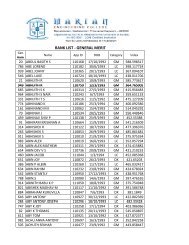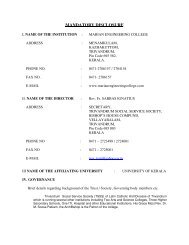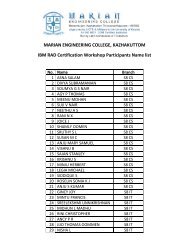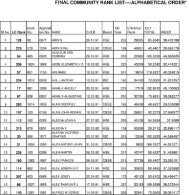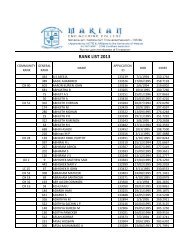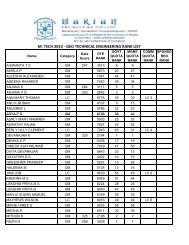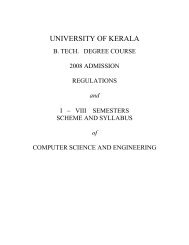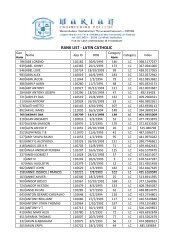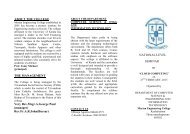UNIVERSITY OF KERALA - College of Engineering, Trivandrum
UNIVERSITY OF KERALA - College of Engineering, Trivandrum
UNIVERSITY OF KERALA - College of Engineering, Trivandrum
Create successful ePaper yourself
Turn your PDF publications into a flip-book with our unique Google optimized e-Paper software.
03.705.1 Elective III THEORY <strong>OF</strong> ELASTICITY<br />
L T P/D Cr<br />
3 1 0 4<br />
Module I<br />
Analysis <strong>of</strong> stress and strain in three dimensions –stress at a point, transformation, principal stress, surface force<br />
and body forces, equations <strong>of</strong> equilibrium. Homogeneous deformation, strain at a point, principal axes <strong>of</strong> strain,<br />
compatibility equations. Invarients <strong>of</strong> stress and strain. Equation <strong>of</strong> theory <strong>of</strong> elasticity, Generalised Hook’s lawreduction<br />
in number <strong>of</strong> elastic constants for orthotropic, transversely isotropic and isotropic media. Stress strain<br />
relations.<br />
Module II<br />
Equations <strong>of</strong> equilibrium in terms <strong>of</strong> displacements conditions <strong>of</strong> compatibility in terms <strong>of</strong> stresses. Method <strong>of</strong><br />
solution <strong>of</strong> the elasticity problems. Stress displacement and mixed methods. The principle <strong>of</strong> superposition. St.<br />
Venant’s principle.<br />
Two-dimensional problems in rectangular coordinates Generalized plane stress and plane strain, Basic<br />
equations, stress functions, solutions by polynomials, Bending <strong>of</strong> a cantilever loaded at free end and bending <strong>of</strong><br />
a beam by uniform load. Solution in the form <strong>of</strong> Fourier series for a simply supported beam subjected to<br />
continuous loads.<br />
Module III<br />
Two-dimensional problems in polar co ordinates, Basic equations in polar co ordinates, Axi-symmetric stress<br />
distribution curved beams, thick cylinders, rotating disc. General solution bending <strong>of</strong> a curved bar by a force at<br />
the end, effect <strong>of</strong> circular holes on stress distribution in plates. Concentrated force at a point <strong>of</strong> a straight<br />
boundary, circular disc subjected to diametrical compression.<br />
Torsion <strong>of</strong> prismatic members, circular cross section, non-circular rectangular and elliptic section, membrane<br />
analogy.<br />
References:<br />
1 S. P. Timoshenko and J.N. Goodier,“Theory <strong>of</strong> elasticity”-, McGraw-Hill<br />
2 I.N. Sokolnik<strong>of</strong>f, “ Mathematical theory <strong>of</strong> elasticity”,McGraw-Hill Inc.,US<br />
3 Ernest E Sechler, “Elasticity in <strong>Engineering</strong>” - Wiley: Chapman & Hall, New York<br />
Question Paper: Duration: 3 hours<br />
The question paper consists <strong>of</strong> Part A and Part B.<br />
Part A is for 40 marks. There will be 8 compulsory short answer questions covering entire syllabus.<br />
Part B is for 60 marks. There will two questions from each module. The candidate has to answer one question<br />
<strong>of</strong> 20 marks from each module.<br />
Note: No charts, tables, codes are permitted in the Examination hall .If necessary relevant data shall be given<br />
along with the question paper by the question paper setter.<br />
76



